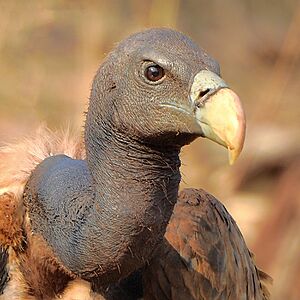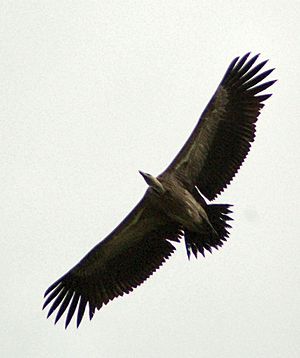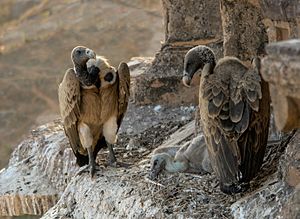Indian vulture facts for kids
Quick facts for kids Indian vulture |
|
|---|---|
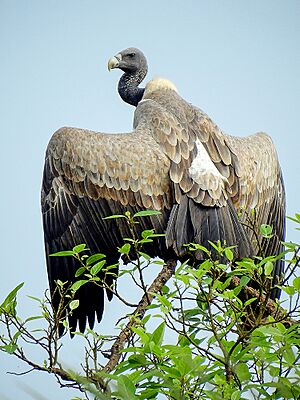 |
|
| Indian vulture | |
| Conservation status | |
| Scientific classification | |
| Genus: |
Gyps
|
| Species: |
indicus
|
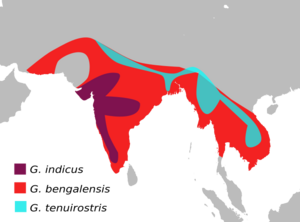 |
|
| Distribution in purple | |
The Indian vulture (Gyps indicus), also called the long-billed vulture, is a large bird of prey. It lives in the Indian subcontinent. This vulture is part of a group called Old World vultures. They belong to the Accipitridae family, which includes eagles and hawks.
Indian vultures are medium-sized birds. They have a small, mostly bald head with few feathers. They also have a long beak and wide, dark wings. These birds usually build their nests on small cliffs and rocky hills. You can find them mainly in central India and south India.
The Indian vulture is a very important animal for its environment. It has been listed as Critically Endangered since 2002. This means its population has dropped a lot. Experts believe there are only about 5,000 to 15,000 adult vultures left in the wild.
The main reason for their decline was a medicine called diclofenac. This drug was given to cattle to help with joint pain. Vultures got poisoned when they ate the meat of dead cattle that had been treated with diclofenac. This caused kidney failure in the vultures. India, Pakistan, and Nepal banned diclofenac in 2006 to help save these birds.
Indian vultures sometimes share their homes with two other types of vultures. These are the slender-billed vulture (Gyps tenuirostris) and the white-rumped vulture (Gyps bengalensis).
Contents
What's in a Name? (Taxonomy)
The Indian vulture belongs to the group of birds called Gyps. This group includes other Old World vultures. Both its common name and its scientific name, Gyps indicus, come from its home in the Indian subcontinent.
The name Gyps comes from an Ancient Greek word gups, which means "vulture". The species name indicus comes from a Neo-Latin word. This word means "Indian" in Ancient Greek.
For a long time, the slender-billed vulture was thought to be a type of Indian vulture. But in 2001, scientists looked at their DNA. They found enough differences to make the slender-billed vulture a separate species.
Where They Live (Distribution and Habitat)
In the past, Indian vultures lived in a wide area. This stretched from southeastern Pakistan to south India. It also went as far east as Indochina and the northern Malay Peninsula.
Today, they are no longer found in South East Asia. Most Indian vultures now live in central and peninsular India. This area is south of the Gangetic plains. You can also find them in southwest Pakistan, Bangladesh, and Nepal.
These vultures live in many different places. They can be found in semi-deserts and dry foothills. They also live in open fields and farmlands near villages. Sometimes, they are even seen near garbage dumps and slaughterhouses in cities.
Indian vultures do not migrate, meaning they don't move to different regions for seasons. But they can fly hundreds of miles in a day looking for food. They usually build their nests on cliffs or tall buildings. They rarely nest in trees.
How They Look (Description)
The Indian vulture is a bulky bird of medium size. Its body and covert feathers are light brown. Its flight feathers are darker. It has white thighs with some scattered white fluff. Its wings are broad, and its tail feathers are short.
Its head is small, bare, and dark brown. It has a long, featherless neck, dark eyes, and a long yellowish beak. The part of its beak near its face, called the cere, is pale green-yellow.
These vultures are about 89 to 103 centimeters (35 to 41 inches) long. Their wingspan can be 2.22 to 2.58 meters (7.3 to 8.5 feet) wide.
Their bald heads help them control their body temperature. When it's cold, they tuck their necks in to stay warm. When it's hot, they stretch their necks out to cool down. Having few feathers on their heads also helps keep them clean. This is important when they put their heads into dead animals to eat.
Indian vultures weigh about 5.5 to 6.3 kilograms (12 to 14 pounds). They are smaller than the Eurasian griffon vulture. You can tell them apart because Indian vultures have a less bulky body and different wing coverts.
Life and Habits (Behaviour and Ecology)
The Indian vulture is a strong flyer. It soars high in the sky using warm air currents called thermals. It can glide at speeds of 35 kilometers per hour (22 mph). It can also fly for six to seven hours without stopping. Indian vultures usually nest on cliffs. They are often found in small groups, sometimes with other types of vultures.
Diet and Feeding
The Indian vulture is a keystone species in its home. This means it plays a very important role in its environment. It is a scavenging bird, which means it mostly eats the bodies of dead animals.
Vultures help keep the ecosystem clean. They remove rotting meat that could otherwise spread diseases. They fly over large areas, sometimes hundreds of miles, looking for dead animals. They mostly use their excellent eyesight to spot food.
Indian vultures are often drawn to places where many other birds of prey or scavengers are gathered. This usually means there is a dead animal nearby. They mainly eat dead cattle and any leftovers from large predators.
Individual vultures often fight for the best spot at a carcass. Since Indian long-billed vultures are smaller than some other species, they sometimes have to step aside for bigger birds.
Lifespan and Mortality
Indian vultures can live for 40 to 45 years. They are ready to have their own babies when they are about five years old. Vultures in the wild might live longer, but they are increasingly found near human areas.
When they are close to people, Indian vultures face more dangers. They can be hit by cars, get shocked by power lines, or crash into trains and other tall structures like windmills.
But the biggest cause of death has been a type of medicine called NSAIDs. One of these, Diclofenac, was commonly given to cattle for joint pain. It is believed that this drug passed into the vultures when they ate the meat of dead cattle. This caused kidney failure and death in the vultures.
Reproduction
Indian vultures build their nests on cliffs, tall buildings, and sometimes on trees. They might even use old monuments and towers. Their nests are platforms made of sticks or twigs. They line them with leaves, sometimes adding fresh green leaves. These green leaves show that the nest is occupied and help keep parasites away.
Indian vultures start breeding when they are about five years old. They begin building nests in September. Breeding happens between November and March. They often form pairs that stay together for life. The female lays only one egg each year. The egg is pure white or has rusty spots.
Both parents take turns sitting on the egg to keep it warm. The egg hatches in about 50 days. Nests are often built near water sources like rivers or lakes. This helps them keep the right amount of moisture in the nests. Most nests are located at higher places, often over 900 meters (about 3,000 feet) high.
Saving the Vultures (Status and Conservation)
Population Decline and Recovery
- Further information: Indian vulture crisis
Starting in the 1990s, the number of Indian vultures dropped very quickly. Over 10 to 15 years, their population in the Indian subcontinent fell by 97%. Because of this fast decline, the species has been listed as critically endangered since 2002. Today, there are only an estimated 5,000 to 15,000 birds left in the wild.
Other related vulture species, like the slender-billed vulture and white-rumped vulture, also saw huge drops in their numbers. Between 2000 and 2007, the Indian vulture population decreased by more than 16% each year.
Scientists found that the main cause of this rapid decline was poisoning from the animal medicine diclofenac. This drug is a non-steroidal anti-inflammatory drug (NSAID). It was commonly given to cattle to ease joint pain. It is believed that the drug passed into the vultures when they ate the meat of dead cattle. This caused kidney failure in the vultures.
Studies showed that even a tiny amount of diclofenac in dead livestock (about 0.8%) could cause a huge drop in vulture numbers. The decline of vultures had a big impact on the environment and people. Vultures are important because they clean up dead animals. Without them, many animal bodies were left to rot. This could spread diseases and increase pests like rats.
The loss of vultures also led to a big increase in stray dogs. Dog bites are the most common cause of rabies in humans. In India, the stray dog population grew by at least 5 million. This led to over 38 million more dog bites and more than 47,000 extra deaths from rabies. This had a huge economic cost.
In March 2006, the government of India banned the use of diclofenac for animals. Another NSAID called Meloxicam was suggested as a safe replacement. It breaks down quickly in animals and is not harmful to vultures. Nepal banned diclofenac in June 2006, and Pakistan followed in September 2006. Drug companies were encouraged to make more meloxicam to lower its cost. In 2015, India ordered smaller sizes for diclofenac vials to reduce the amount given to cattle. In 2021, another safe alternative, tolfenamic acid, was found.
After the ban in 2006, the vulture population started to recover. Their numbers were stable until 2011. However, some states in India still reported declines. Even though diclofenac was banned and its use dropped by about 50%, it was still sometimes available. Other harmful drugs like aceclofenac and ketoprofen were also being used. In 2008, the Indian government made selling diclofenac a crime that could lead to jail time. Later surveys showed that the population was slowly recovering. The decline has slowed a lot in India, Pakistan, and Nepal due to the strict ban.
Conservation Efforts
Programs to breed Indian vultures in zoos were started to help their numbers grow. Vultures live a long time and breed slowly. They are also hard to breed in captivity. So, these programs are expected to take a long time. The vultures bred in these programs will be released into the wild once the environment is safe from diclofenac.
In 2014, a program called Saving Asia's Vultures from Extinction was announced. It aimed to release captive-bred birds by 2016. In 2016, the Jatayu Conservation Breeding Centre, Pinjore released captive-bred vultures. This was Asia's first program to reintroduce vultures into the wild. Small numbers of birds have also bred in the wild in Karnataka and Tamil Nadu. Three more breeding centers have been set up in West Bengal, Assam, and Madhya Pradesh. There are also four smaller facilities working with zoos.
In 2020, the Ministry of Environment, Forest and Climate Change in India launched a Vulture Action Plan for 2020-2025. This plan aims to increase conservation efforts. It also wants to make sure that other toxic drugs, not just diclofenac, are banned for animal use.
In 2010, a small group of Indian vultures and three other vulture species were found in the Moyar river valley. This was in the Sathyamangalam Wildlife Sanctuary. Twenty nests were seen, with about 40 adult vultures. Indian vultures had not been seen in this area since the 1970s. This rediscovery is very important for their conservation.
Vultures in Culture and Economy (Cultural and Economic Significance)
Indian vultures are often misunderstood. People sometimes fear them or see them as lowly creatures because they eat dead animals. However, they play a very important ecological role. They are excellent scavengers.
In the Indian subcontinent, there are many cattle and few ways to dispose of dead animals. Vultures effectively clean up these carcasses. This helps improve public health and saves money.
Jatayu is a special character in the Hindu epic story Ramayana. He is a demigod who looks like an eagle or a vulture.
The Parsi community in India has a unique tradition. They leave dead bodies in high towers called Tower of Silence. This allows vultures to feed on them.



